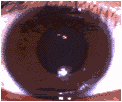Iridologists ha
 ve said that there are only two basic colors for the iris, blue and brown. Perhaps this was so, but now there has been so much intermarriage of races in the world that we likely have a genetic mix of colors. Of course, we usually see the basically blue or brown iris but there are irises which we call "mixed" when it becomes obvious that in addition to the basic color there is a strong genetic influence of another color. There are instances where it becomes very difficult to determine exactly which color is the true basic color. Also, drug settlements in the body can make the iris appear a color which is different than its true and basic color.
ve said that there are only two basic colors for the iris, blue and brown. Perhaps this was so, but now there has been so much intermarriage of races in the world that we likely have a genetic mix of colors. Of course, we usually see the basically blue or brown iris but there are irises which we call "mixed" when it becomes obvious that in addition to the basic color there is a strong genetic influence of another color. There are instances where it becomes very difficult to determine exactly which color is the true basic color. Also, drug settlements in the body can make the iris appear a color which is different than its true and basic color. Brown Eyed Type (German: Hematogenic)
Description
Pure brown eye with pigments covering iris fiber structure. Related to the primary color red and the physical aspect of health. Probably Chinese constitutional types: fire and earth. Probability related to Western fire and earth constitutions as well.
Tendencies
Pure brown eyes are difficult for Iridologists to read because a layer of pigment completely covers up the fiber structure of the eye. However, Iridologists have noted some general characteristics of brown-eyed people. First, they appear to be pre-disposed to imbalances in blood composition and hence to blood disorders. It has been suggested that they have a possible inherent inability to store adequate supplies of minerals. They may especially have problems with calcium metabolism. Specific systems and organs to pay particular attention to are: The circulatory system (heart, blood, blood vessels), the organs that make blood (liver, spleen, bone marrow), the digestive system and the endocrine glands.
Common health problems experienced by brown-eyed people include: Anemia, hardening of the arteries, all types of blood diseases, constriction and hardening of lymph tissue, possible reduced leukocytes in the blood, digestive troubles, mineral deficiencies and early breakdown of the endocrine glands.
For more information about Iridology and it's history, please contact

No comments:
Post a Comment